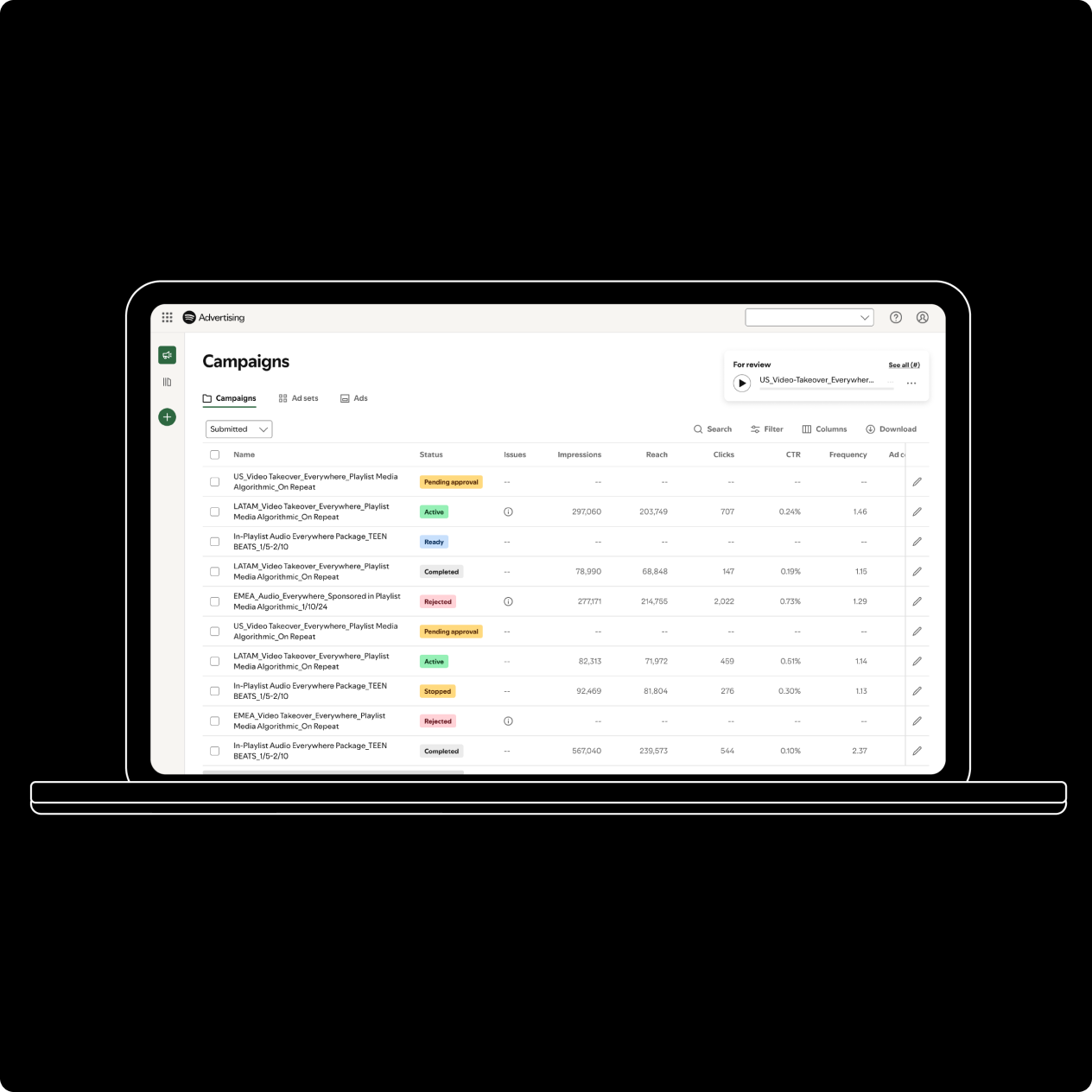
Spotify Ad Studio: Complete Buyer's Guide
Comprehensive AI-powered audio advertising platform
Spotify Ad Studio represents a comprehensive AI-powered audio advertising platform that combines generative creative tools with programmatic delivery capabilities across Spotify's 675M+ active user base. The platform addresses two critical market needs: reducing traditional audio ad production timelines from 4–6 weeks to minutes through AI automation, and enabling real-time personalization at scale through its Spotify Ad Exchange (SAX) programmatic infrastructure[43][44][56].
Market Position & Maturity
Market Standing
Spotify Ad Studio operates from a position of significant market strength, leveraging Spotify's established ecosystem of 675M+ active users across 20+ global markets[43][46].
Company Maturity
The platform benefits from Spotify's mature infrastructure and strategic partnerships with major demand-side platforms including Google DV360, Magnite, and Trade Desk[43][57].
Growth Trajectory
Operating within an audio advertising market projected to grow from $38.157 billion in 2025 to $51.110 billion by 2030[16], Spotify Ad Studio benefits from structural market tailwinds.
Industry Recognition
The platform's 93% ad engagement transfer rate from content to advertising represents a unique competitive moat stemming from Spotify's dual role as content platform and advertising medium[53].
Strategic Partnerships
Strategic partnerships with Google DV360, Magnite, and Trade Desk provide enterprise-grade programmatic access[43][57].
Longevity Assessment
Spotify's established market position and revenue diversification beyond advertising provide platform stability that pure-play advertising technology vendors cannot match.
Proof of Capabilities
Customer Evidence
Iron Mountain achieved a 19-point increase in message association and 12-point lift in brand awareness using AI-generated audio ads across UK, Germany, and MENA regions[45].
Quantified Outcomes
Contiki generated a 267% surge in website clicks and achieved 32% higher channel performance versus alternatives through multi-format AI-driven campaigns[54][55].
Case Study Analysis
Intel reduced ad creation from traditional 4–6 weeks to 3 minutes using hyper-personalization features[46][47].
Market Validation
Customer retention and expansion evidence includes enterprise clients utilizing the AUX consultancy for end-to-end campaign management, including established brands like Visa and Coca-Cola[44].
Competitive Wins
Contiki reported 32% higher channel performance versus alternatives, indicating the platform's ability to outperform existing solutions in head-to-head comparisons[54][55].
Reference Customers
Enterprise clients include Visa and Coca-Cola, demonstrating established enterprise sales capabilities and support infrastructure[44].
AI Technology
Spotify Ad Studio's AI technology foundation centers on integrated generative capabilities within the Ads Manager interface, enabling script and voiceover generation from simple prompts[44][55].
Architecture
The CAMoE (Cross-Modal Optimization) framework integrates listener context including device, location, and listening behavior to achieve 4.8% eCPC reduction[31].
Primary Competitors
Competitors like Amazon Audio Generator and Wondercraft offer specialized capabilities in voice interaction and multilingual features, respectively[10][19][23][30].
Competitive Advantages
Spotify Ad Studio's core differentiation lies in combining creative AI tools with direct access to first-party listener data across 675M+ users, eliminating middleware dependencies affecting competitors[38][46].
Market Positioning
Spotify Ad Studio operates in a fragmented competitive landscape where no single vendor dominates enterprise deployments.
Win/Loss Scenarios
The platform wins when organizations prioritize integrated creative and programmatic capabilities with direct audience access over specialized point solutions.
Key Features

Pros & Cons
Use Cases
Integrations
Pricing
Featured In Articles
Comprehensive analysis of AI Audio Ads for AI Marketing & Advertising for AI Marketing & Advertising professionals. Expert evaluation of features, pricing, and implementation.
How We Researched This Guide
About This Guide: This comprehensive analysis is based on extensive competitive intelligence and real-world implementation data from leading AI vendors. StayModern updates this guide quarterly to reflect market developments and vendor performance changes.
57+ verified sources per analysis including official documentation, customer reviews, analyst reports, and industry publications.
- • Vendor documentation & whitepapers
- • Customer testimonials & case studies
- • Third-party analyst assessments
- • Industry benchmarking reports
Standardized assessment framework across 8 key dimensions for objective comparison.
- • Technology capabilities & architecture
- • Market position & customer evidence
- • Implementation experience & support
- • Pricing value & competitive position
Research is refreshed every 90 days to capture market changes and new vendor capabilities.
- • New product releases & features
- • Market positioning changes
- • Customer feedback integration
- • Competitive landscape shifts
Every claim is source-linked with direct citations to original materials for verification.
- • Clickable citation links
- • Original source attribution
- • Date stamps for currency
- • Quality score validation
Analysis follows systematic research protocols with consistent evaluation frameworks.
- • Standardized assessment criteria
- • Multi-source verification process
- • Consistent evaluation methodology
- • Quality assurance protocols
Buyer-focused analysis with transparent methodology and factual accuracy commitment.
- • Objective comparative analysis
- • Transparent research methodology
- • Factual accuracy commitment
- • Continuous quality improvement
Quality Commitment: If you find any inaccuracies in our analysis on this page, please contact us at research@staymodern.ai. We're committed to maintaining the highest standards of research integrity and will investigate and correct any issues promptly.